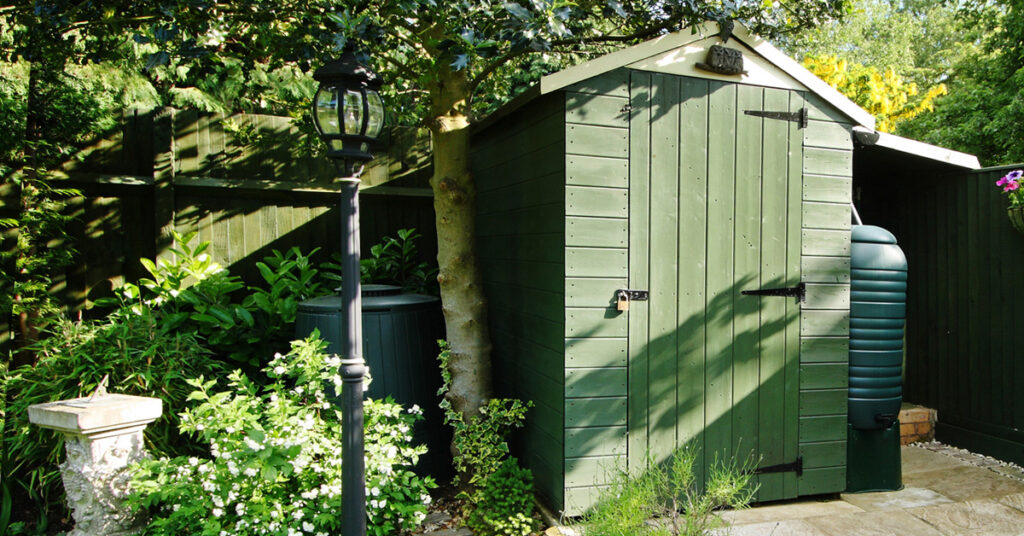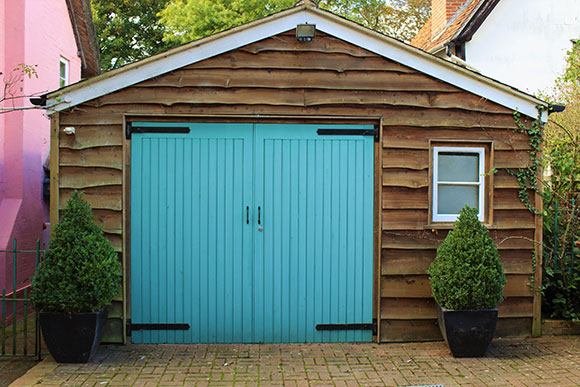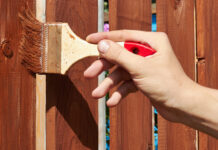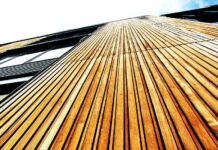Garden sheds and summer houses can often go neglected in the bitterness of the winter months. Peeling paint and discoloured timber can make an eyesore of your garden. It can be difficult to know where to start with products. This article will take you through our recommendations and explain the differences between the most popular options.
Featured products
Premium (£££)
Mid-range (££)
Budget-Friendly (£)

Preparation
If your shed has not been painted:
Before you begin with a product, we advise you ensure the integrity of your shed/summer house. If you have any splinters or rough edges on your timber, we recommend you use some sand paper. Sanding down your shed will create a smoother base for your product to stick. Rough areas such as corners or chipped wood can also benefit from being sanded.
Make sure to use masking tape to section off the door and window panes and protect them from staining.
Once you have finished sanding, you can begin cleaning. This will not be necessary if your shed has only recently been built. But if your timber has seen better days and is covered in grime, using a specialised cleaning product can help breathe new life into it. Removing all dirt and algae will give you a clean base to apply your product and give a seamless finish.
Before moving onto the products, we suggest beginning with a test area, this will ensure that you are happy with the colour and to avoid disappointment. Ensure you are wearing sufficient protective gear before starting and that your timber is completely dry.
If your shed has previously been painted:
If your shed is covered in a coat of peeling paint, we recommend you remove this layer using a paint stripper. Sanding down the area before applying the product will give a smoother finish. We also recommend you use a stripping knife with the product as this will remove the previous coat more effectively.
When using a paint stripper, be sure to read the instructions before use and be sure to protect the window panes and door.
After use, ensure that there are no remaining traces of product by thoroughly cleaning the surface area.
As mentioned previously, we always recommend beginning with a test area, this will ensure that you are happy with the colour and to avoid disappointment. Don’t forget protective gear before starting!

Products
This article will list several different combinations of products, from budget-friendly picks to more premium options, and also looking at the overall finish. Have a read through and see which one you prefer.
Premium: Osmo
To start, we suggest a base coat. This will protect the wood and create a base layer for further products to stick to. The Osmo WR Base Coat is a great choice as it preserves the wood and protects against rot, mildew and insect infestations. This powerful formula repels water to reduce the risk of shrinking and swelling. It is also incredibly versatile, being suitable for use on most exterior wood such as windows, frames, doors, garden furniture etc. This product acts as a protective base coat and requires an exterior oil-based finish to ensure complete protection and high-quality finish.
If you are wanting to achieve a professional, picture-perfect look, we recommend the Osmo UV Protection Oil Extra. This impressive formula holds up against weather damage and does not crack, peel, blister or flake. Made from a blend of natural oils, waxes, and resins, Osmo UV Protection Oil Extra offers excellent durability, water resistance and protection against mould, algae, fungal attack, and the bleaching effects of the Sun’s UV rays. Both easy-to-apply and easy-to-maintain, this product is also very versatile. Suitable for use on all vertical exterior timber, you can use this on your doors, window frames, carports, balcony, fences and garden furniture.
The Osmo Country Shades is a tinted oil and provides long-term protection. Available in a range of colours, with natural pre-mixed shades or make your own shade, this product is highly durable against weather and UV damage. Being both water-resistant and dirt-resistant, this high-performing formula gives a powerful finish whilst still maintaining a natural look. This product is also microporous, allowing the wood to breathe and reducing the risk of swelling or shrinking that when paired with the Base Coat is highly effective. This versatile formula is suitable for a wide range of exterior timbers projects, such as garden furniture, summer houses, fences, trims, shutters and cladding- giving you your moneys worth!
Oil vs Paint
Whilst the Oils enhances the natural grain of the wood and stain the wood, paints hides the natural grain of the wood with their higher coverage formulas. Depending on the finish you are wanting to achieve, it is worth considering each product and its suitability for your project.
The main differences are as follows:
| Pro’s: | Con’s: | |
| Stains: | Enhance the grain of the wood | Requires a new coat every 18 months |
| Paints: | More colour choice | Covers the natural grain of the wood |
It is worth noting that all of the products mentioned in the Osmo range are high V.O.C, meaning they are meant to be used outside due to the chemicals used in the formulas.
Mid-range: Barrettine or Sadolin
If your timber has not been tanalised or preserved recently, we suggest you begin with the Barrettine Premier Universal Preserver. This product acts as a primer and protects the wood against fungi, mould and insect infestations. Its wax-free formula will build a solid foundation to protect your wood and preserve its longevity. Wood should be preserved every 5-6 years.
If your shed has already been tanalised recently, skip the preserver and move on to the Barrettine Log Cabin Treatment. Don’t let the name put you off, this product is multi-use and highly effective. This product is to be used as a top coat to protect against water ingress. It also offers protection against UV damage, mould and algae. The formula prevents cracking, splitting and warping of the timber which is a common issue with exterior timber. Barrettine are a trusted brand and their expert products never fail to meet expectations. This product is also suitable for use on decking, summer houses, sheds and fences.
This combination of products is ideal if you are don’t want to change the colour of your timber but want to add some protection. The Preservative and the Treatment will provide a barrier to the elements and only needs reapplication every twelve months.
However, if you were wanting to ditch the treatment and opt for a more full-coverage, vibrant option, consider Sadolin Superdec. Available in 60+ shades, this self-priming paint is perfect for all exterior joinery. With a flexible finish, it is resistant to cracking and peeling. Their high-coverage formula can be used on a variety of different materials including metal, concrete and masonry. Offering up to 10 years protection, Sadolin Superdec is a great choice for those wanting a rich, opaque finish.
Budget-friendly: Cuprinol
If you are wanting to paint your shed/summerhouse, we recommend starting with the Cuprinol Wood Preserver on untanalised timber. If your wood has already been preserved or treated in the past few years, move on to the painting. For the paint, we love the Cuprinol Garden Shades paint. This budget-friendly option comes in a range of colours and leaves an opaque yet natural finish that showcases the natural grain of the wood. The Cuprinol range differs from the previously mentioned collections as these Cuprinol products are water-based as opposed to solvent-based.
| Water-based | Solvent-based |
| Less sheen but last longer | Higher gloss but fade over time |
| Low V.O.C levels | High V.O.C levels |
| More eco-friendly | Shorter drying times |
The Cuprinol Garden Shades paint has a long-lasting formula that offers up to six years protection whilst also boasting a competitive price. This paint has a thin consistency which allows the natural grain of the wood to remain seen. Versatile in its use, the formula can be used on wood, terracotta, stone and brick. Fully weather-resistant and a drying time of just one hour, it’s no wonder this product is so popular.
Overview
Each combination of products will give a different finish so we advise you research each product to ensure you are happy with your purchases. But to save you time, we will make it simple.
| Coloured or Clear? | Natural or Opaque? | Price | |
| Osmo UV Protection Oil Extra | Available in Clear or Natural Wood Tones | Natural | £££ |
| Osmo Country Colour | Coloured | Opaque | £££ |
| Barrettine Log Cabin Treatment | Clear | Natural | ££ |
| Sadolin Superdec | Coloured | Opaque | ££ |
| Cuprinol Garden Shades | Coloured | Opaque | £ |
We hope this article has been helpful and informative. If you have any questions, comment below or call one of our experts on 01303 213838.
For more ‘how-to’ guides and inspiration, check out our blog. For product demonstrations, visit our Youtube channel.
FAQs
Do I need to treat the inside of my shed/summer-house?
This depends on what the shed/summerhouse is being used for and how often it’s being used. Although interior walls and floors can be left untreated, treating them can help to protect the wood, make cleaning far easier and add some colour and style to the interior of your summer house.
For floors, use a dedicated flooring product such as Ronseal Diamond Hard Floor Paint, Ronseal Diamond Hard Coloured Floor Varnish or for a clear finish, Manns Extra Tough Floor Varnish.
Hard Wax Oils such as Osmo Polyx Oil and Fiddes Hard Wax Oil will help to protect the natural wood of the floor from dust, dirt and grime whilst making it easier to clean. Walls and ceilings can also be painted, varnished or oiled if desired. It’s worth noting that clear oils and varnishes on pine timbers will draw out the natural colour and grain of the wood. In some cases this can produce a fairly strong orange or yellow colouration to the wood. For this reason we always recommend trialling a test area before proceeding with the project.
Advice needed on how to waterproof a shed?
Our advice on how to waterproof a shed, especially a new shed is to treat all exterior facing sides and panel edges with 2 coats of an exterior wood preservative, followed by 2 coats of an exterior wood oil prior to the shed being constructed.
Older sheds or sheds that have recently been constructed should first be cleaned with a wood cleaner such as Barrettine Mould and Mildew Cleaner. This is to remove and kill off any mould, mildew or algae spores that are either on the surface or in the surface of the wood fibres. once this has been done, treat all visible surfaces as above with 2 coats of an exterior wood preserver followed by 2 coats of an exterior wood oil suitable for sheds or a decking oil. This will provide an excellent weather protective finish that can be easily maintained year after year by simply applying a maintenance coat of wood oil.
An alternative to the above is to use a high quality exterior wood paint or an Exterior wood varnish.
Is shed paint the same as fence paint?
Essentially, yes. If a paint can be used on one, it can be used on the other. The main purpose of an outdoor paint is to protect the timber and give it colour. A paint will do the same job on both projects.
Do I need to sand a shed before painting?
If you’re painting an old shed which has previously been painted, then yes. Sanding the shed will remove the layer of old paint, giving you a blank canvas to start from. Remember to sand in the direction of the woodgrain and you should be good to go.
How soon after rain can I paint my shed?
To allow for the products to dry properly, it is important that you give your shed at least 3-4 days before application. These days must be If your shed isn’t properly dry, it can cause the paint to not cure, leaving you with a sticky surface.
How many coats of paint does a shed need?
This depends on the formula but as a general rule of thumb, 2 coats on top of a preserver will give your shed a gorgeous finish.




